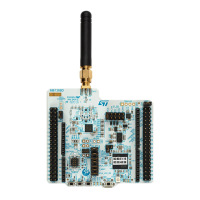RM0453 Rev 5 1049/1450
RM0453 Inter-integrated circuit (I2C) interface
1113
34 Inter-integrated circuit (I2C) interface
34.1 Introduction
The I
2
C (inter-integrated circuit) bus interface handles communications between the
microcontroller and the serial I
2
C bus. It provides multimaster capability, and controls all I
2
C
bus-specific sequencing, protocol, arbitration and timing. It supports Standard-mode (Sm),
Fast-mode (Fm) and Fast-mode Plus (Fm+).
It is also SMBus (system management bus) and PMBus
®
(power management bus)
compatible.
DMA can be used to reduce CPU overload.
34.2 I2C main features
• I
2
C bus specification rev03 compatibility:
– Slave and master modes
– Multimaster capability
– Standard-mode (up to 100 kHz)
– Fast-mode (up to 400 kHz)
– Fast-mode Plus (up to 1 MHz)
– 7-bit and 10-bit addressing mode
– Multiple 7-bit slave addresses (2 addresses, 1 with configurable mask)
– All 7-bit addresses acknowledge mode
– General call
– Programmable setup and hold times
– Easy to use event management
– Optional clock stretching
– Software reset
• 1-byte buffer with DMA capability
• Programmable analog and digital noise filters
The following additional features are also available, depending on the product
implementation (see Section 34.3):
• SMBus specification rev 3.0 compatibility:
– Hardware PEC (packet error checking) generation and verification with ACK
control
– Command and data acknowledge control
– Address resolution protocol (ARP) support
– Host and device support
– SMBus alert
– Timeouts and idle condition detection
• PMBus rev 1.3 standard compatibility
• Independent clock: a choice of independent clock sources allowing the I2C
communication speed to be independent from the PCLK reprogramming

